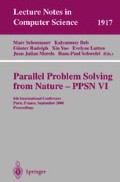Abstract
There are evolutionary trajectories in two different but related spaces, design space and niche space. Co-evolution occurs in parallel trajectories in both spaces, with complex feedback loops linking them. As the design of one species evolves, that changes the niche for others and vice versa. In general there will never be a unique answer to the question: does this change lead to higher fitness? Rather there will be tradeoffs: the new variant is better in some respects and worse in others. Where large numbers of mutually interdependent species (designs) are co-evolving, understanding the dynamics can be very difficult. If intelligent organisms manipulate some of the mechanisms, e.g. by mate selection or by breeding other animals or their own kind, the situation gets even more complicated. It may be possible to show how some aspects of the evolution of human minds are explained by all these mechanisms.
Access this chapter
Tax calculation will be finalised at checkout
Purchases are for personal use only
Preview
Unable to display preview. Download preview PDF.
References
Chalmers, D.J.: The Conscious Mind: In Search of a Fundamental Theory. Oxford University Press, New York, Oxford, 1996.
Cohen, J., Stewart, I.: The collapse of chaos. Penguin Books, New York, 1994.
Damasio, A.R.: Descartes’ Error, Emotion Reason and the Human Brain. Grosset/Putnam Books, New York, 1994.
Dawkins, R.: The Extended Phenotype: The long reach of the gene. Oxford University Press, Oxford, New York, 1982.
Dennett, D.C.: Kinds of minds: towards an understanding of consciousness. Weidenfeld and Nicholson, London, 1996.
Goleman, D.: Emotional Intelligence: Why It Can Matter More than IQ. Bloomsbury Publishing, London, 1996.
Kauffman, S.: At home in the universe: The search for laws of complexity. Penguin Books, London, 1995.
Logan, B.S, Sloman, A.: Agent route planning in complex terrains. Technical Report CSRP-97-30, University of Birmingham, School of Computer Science, 1997.
Maynard Smith, J., Szathmaŕy, E.: The Origins of Life: From the Birth of Life to the Origin of Language. Oxford University Press, Oxford, 1999.
Milner, R.: Semantic ideas in computing. In Ian Wand and Robin Milner, editors, Computing Tomorrow: Future research directions in computer science, 246–283. Cambridge University Press, 1996.
Minsky, M.L.: The Society of Mind. William Heinemann Ltd., London, 1987.
Peterson, D.M. (editor): Forms of representation: an interdisciplinary theme for cognitive science. Intellect Books, Exeter, U.K., 1996.
Poli, R: Logan, B.S.: On the relations between search and evolutionary algorithms. Technical Report CSRP-96-07, School of Computer Science, The University of Birmingham, March 1996.
Popper, K.R.: Unended Quest. Fontana/Collins, Glasgow, 1976.
Scheutz, M.: When physical systems realize functions... Minds and Machines, 9:161–196, 1999. 2.
Sloman, A.: How to derive “better” from “is”. American Phil. Quarterly, 6:43–52, Jan 1969.
Sloman, A.: The mind as a control system. In C. Hookway and D. Peterson, (eds), Philosophy and the Cognitive Sciences, 69–110. Cambridge University Press, 1993.
Sloman, A.: Explorations in design space. In A.G. Cohn, editor, Proc. 11th European Conf. on AI, Amsterdam, August 1994, 578–582, Chichester, 1994. John Wiley.
Sloman, A.: Semantics in an intelligent control system. Philosophical Transactions of the Royal Society: Physical Sciences and Engineering, 349(1689):43–58, 1994.
Sloman, A.: Exploring design space and niche space. In Proc. 5th Scandinavian Conf. on AI, Trondheim, Amsterdam, 1995. IOS Press.
Sloman, A.: Towards a general theory of representations, in Peterson (1996). In Peterson, D.M: (ed), Forms of representation: an interdisciplinary theme for cognitive science, 118–140. 1996.
Sloman, A.: What sort of control system is able to have a personality. In Trappl, R., Petta, P.: (eds), Creating Personalities for Synthetic Actors: Towards Autonomous Personality Agents, 166–208. Springer (Lecture Notes in AI), Berlin, 1997.
Sloman, A.: Damasio, Descartes, alarms and meta-management. In Proc. Int. Conf. on Systems, Man, & Cybernetics (SMC98), San Diego, 2652–7. IEEE, 1998.
Sloman, A.: The “semantics” of evolution: Trajectories and trade-offs in design space and niche space. In Coelho, C: (ed), Progress in Artificial Intelligence, 6th Iberoamerican Conf. on AI, 27–38. Springer, Lecture Notes in Artificial Intelligence, Lisbon, October 1998.
Sloman, A.: What sort of architecture is required for a human-like agent? In Wooldridge, A. Rao, A.: (eds), Foundations of Rational Agency, 35–52. Kluwer Academic, Dordrecht, 1999.
A. Sloman and B. S. Logan. Architectures and tools for human-like agents. In Ritter, F., Young, R.M., (eds), Proc. the 2nd European Conf. on Cognitive Modelling, 58–65, Nottingham, UK, 1998. Nottingham University Press.
Sloman, A.: Architecture-based conceptions of mind. In Proc. 11th Int. Congress of Logic, Methodology and Philosophy of Science, Cracow, Poland, August 1999.
Sloman, A.: Architectural requirements for human-like agents both natural and artificial, (what sorts of machines can love?). In Kerstin Dautenhahn, editor, Human Cognition And Social Agent Technology, Advances in Consciousness Research, 163–195. John Benjamins, Amsterdam, 2000.
Sloman, A., Logan, B.S.: Building cognitively rich agents using the Sim_agent toolkit. Communications of the Association of Computing Machinery, 42(3):71–77, March 1999.
Sloman, A and Logan, B. Evolvable architectures for human-like minds. In Proc. 13th Toyota Conf., on Affective Minds Shizuoka, Japan, Nov–Dec 1999. Elsevier, 2000.
Author information
Authors and Affiliations
Editor information
Editors and Affiliations
Rights and permissions
Copyright information
© 2000 Springer-Verlag Berlin Heidelberg
About this paper
Cite this paper
Sloman, A. (2000). Interacting Trajectories in Design Space and Niche Space: A Philosopher Speculates About Evolution. In: Schoenauer, M., et al. Parallel Problem Solving from Nature PPSN VI. PPSN 2000. Lecture Notes in Computer Science, vol 1917. Springer, Berlin, Heidelberg. https://doi.org/10.1007/3-540-45356-3_1
Download citation
DOI: https://doi.org/10.1007/3-540-45356-3_1
Publisher Name: Springer, Berlin, Heidelberg
Print ISBN: 978-3-540-41056-0
Online ISBN: 978-3-540-45356-7
eBook Packages: Springer Book Archive

